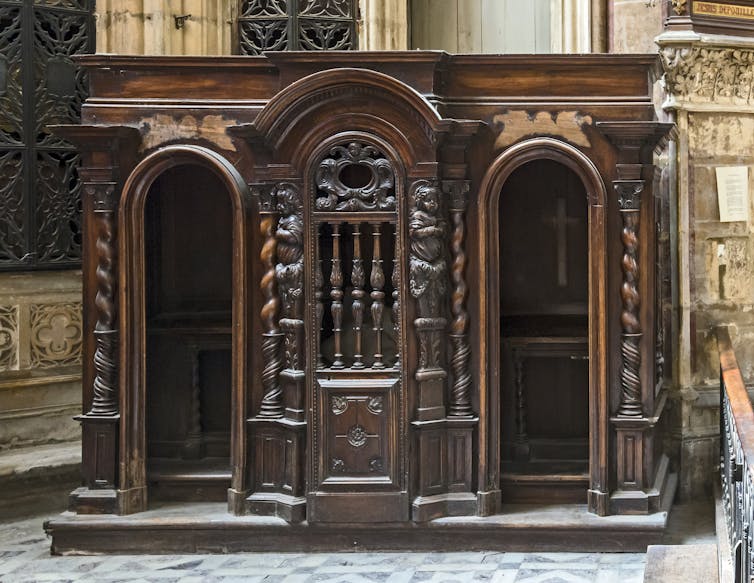(RNS) — James Lindsay made his name submitting hoax articles to academic journals to mock liberals. Now he’s after Christian nationalists — by submitting a fake article taken mostly from the Communist Manifesto.

James Lindsay presents a session of "The EVILution of Communism Workshop"
for New Discourses, Nov. 4, 2024. (Video screen grab)
Bob Smietana
December 5, 2024
(RNS) — An atheist writer and critical race theory critic who made his name submitting fake articles for publication in progressive academic journals and later attacking “liberal” evangelicals has a new target: conservative Christian nationalists.
James Lindsay, who describes himself as a “professional troublemaker,” rewrote parts of “The Communist Manifesto,” adding some critiques of “the liberal establishment,” and then sent it off to the American Reformer, an online magazine that seeks to “promote a vigorous Christian approach to the cultural challenges of our day.”
The essay, published with a fake byline of “Marcus Carlson,” was published in mid-November, and begins with a lead that mimics the work of Karl Marx and Friedrich Engels.
“A rising spirit is haunting America: the spirit of a true Christian Right,” the essay begins, reminiscent of the opening lines of “The Communist Manifesto”: “A spectre is haunting Europe — the spectre of communism.”

Karl Marx, circa 1865. (Photo via Roger Viollet Collection/Getty Images/Public Domain)
The idea, Lindsay explained, was to embarrass what he described as “Woke Right” conservatives by getting them to publish the works of actual communists.
“They published Karl Marx’s definitive Communist work, dressed up to resemble their own pompous, self-pitying drivel, when it was submitted from a completely unknown author with no internet footprint whatsoever bearing the name ‘Marcus Carlson,’” Lindsay wrote in revealing his hoax, an announcement that coincided with the magazine’s “Giving Tuesday” campaign.
The founder of American Reformer seemed to take the hoax in stride.
“Well, you have to hand it to James Lindsey — he ‘got us,’” Josh Abbotoy, co-founder of American Reformer, wrote on X, the platform formerly known as Twitter, referring to Lindsay’s hoax.
The publication’s editors, who did not respond to a request for comment, added Lindsay’s byline to the story but did not retract it. However, in an editor’s note, they wrote that they’d be beefing up their editorial screening — and noted Lindsay’s lack of faith.
“The following article was written by James Lindsay, who, as an avowed atheist, is not eligible for publication in American Reformer,” the editors wrote.
The Karl Marx hoax is the latest twist in the story of Lindsay, a former massage therapist with a Ph.D. in mathematics who reinvented himself as an internet gadfly and self-proclaimed enemy of “woke” Americans — and an occasional ally of conservative Christians.
Lindsay first came to fame in 2018, when he and a pair of co-authors submitted a series of papers to what they called “grievance studies” academic journals, including one paper about “fat bodybuilding” and another about sex at dog parks. Some of the journals published the papers — which included fake research and, in one instance, a similar strategy of updated passages of Hitler’s “Mein Kampf” with buzzy academic phrases — launching Lindsay into a career in mocking so-called woke liberals and critical race theory.
RELATED: Why grievance studies hoaxer and atheist James Lindsay wants to save Southern Baptists
He later teamed up with some conservative Southern Baptists who claimed their denomination had become too liberal, especially making videos about the “woke invasion” with Michael O’Fallon, an activist who also organized cruises for Calvinist Christian nationalists.
In 2023, conservative activist Charlie Kirk interviewed Lindsay at a Turning Point USA event for pastors, claiming he’d traveled the country with the atheist activist, trying to convince Christians to fight liberals.
Lindsay, who did not respond to a request for an interview, has now turned against what he calls “The Woke Right,” which he described on his podcast as conservatives using “woke methods” to promote conservative values.
The term “woke” was popularized during the protests that followed the death of George Floyd, as a way of saying that people were aware of systemic racism. That led to a conservative backlash, including from some evangelical groups who objected to any mention of social justice in religious circles.
By 2022, some conservatives had begun to turn the phrase on their own, accusing others in their ranks of being divisive extremists who seek out conflict.
“If the first words out of their mouth, for instance, are ‘establishment’ and ‘globalists,’ you can rest assured they are not very thoughtful and they are probably about to lie to you,” U.S. Rep. Dan Crenshaw, a Republican from Texas, told the Texas Tribune in 2022. “I’m just sick of it because it’s manufactured division.”
Neil Shenvi, a popular blogger and critic of critical race theory, labeled Christian nationalists such as Stephen Wolfe, author of “The Case for Christian Nationalism,” as part of the “woke right” for promoting the idea that conservative Christians — especially white Christians — are being oppressed by liberals.
Lindsay has taken up the fight, putting him at odds with the American Reformer and groups like it. Stephen Wolfe has also been among his targets, as has former Trump administration staffer turned Southern Baptist critic William Wolfe, Gab founder Andrew Torba, Candice Owen, Tucker Carlson and Joel Webbon, a Texas pastor known for his antisemitic takes, claims of “anti-white discrimination” and his hopes to ban women from voting.
The American Reformer hoax set off a social media feud between Lindsay’s allies and the supporters of those he criticized — with Lindsay’s post on X about the matter receiving 1.9 million views and 666 comments as of Thursday morning (Dec. 5).
While the American Reformer’s editors were fooled by the hoax, some of its readers were not. Within days of the article’s publication, readers noticed something was off and suspected plagiarism. “So, as an old commercial would go, is the above article real or is it memorex?” wrote a reader in the comments.







